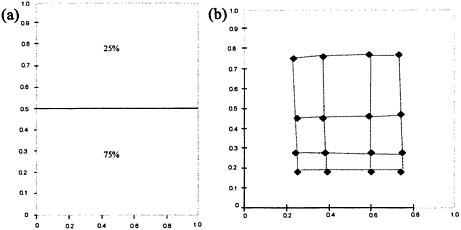27.
| [Cover] [Contents] [Index] |
Page 121

Figure 3.9 (a) 75% random training samples used to train a SOM fall within the shaded area; the remaining area contains 25% of random samples, (b) Result of weight distribution after 6,000 iterations. Most of the output neurones are located inside the shaded area.
ations is shown in Figure 3.9b, which is clearly different from the results presented in Figure 3.8d. Most of the weights in Figure 3.9b are distributed within the shaded area. Only four of the sixteen neurones are located in the remaining area. These examples indicate that a change in sample size will result in change in SOM performance. Therefore, if one intends to distinguish slight difference within some specific feature domain, then more samples within that area should be presented in order to weight the SOM towards the area of interest.
One of the capabilities of SOM is to achieve a non-linear mapping of the feature space (Kraaijveld et al., 1995), which can be used to reduce the input data dimension. Principal component analysis (PCA, Chapter 2) is often used for data dimension reduction. PCA is based on the eigenvalues and eigenvectors of the variance-covariance (or correlation) matrix of the data set. Such a method is linear and has its drawbacks. The simplest example involves just two dimensions. If the data distribution on a two-dimensional space has a correlation of near zero, one may experience difficulty in using PCA to perform a suitable data mapping. However, by using a SOM, the resulting weights will be located in such a way as to match the shape of data distribution. Such a mapping is non-linear and may more clearly reflect the data distribution than linear mappings such as PCA. Kraaijveld et al. (1995) provide a detailed description of the use of SOM in non-linear mappings.
| [Cover] [Contents] [Index] |
EAN: 2147483647
Pages: 354